A fiesta in Bolivia is sure to be a memorable treat. Bolivia festivals are loud, lively, colourful, massive; some of them involve thousands of costumed dancers and food and alcohol aplenty. What more, they’re a dive into the intricate heart of the Andean culture, this patchwork of native and Christian traditions. With dozens of celebrations throughout the year, hopefully something will coincide with your trip. Or take it a step further and choose your Bolivia travel dates in order to include one or more of these fascinating celebrations.
Traditional festivals in Bolivia
As you’ll see in this list of selected festivals of Bolivia, religion plays a big role in the country. In the Andes, religion is always a strange and surprising mix of the Catholicism brought by the colons and the deep-rooted beliefs of the different native peoples. Bolivia prides itself on its diverse identity –even naming itself a ‘plurinational state’–, and that’s for the best! It makes for a colourful country whose palette is best admired during the most traditional Bolivian festivals.
The largest indigenous groups in Bolivia are the Aymara and the Quechua; therefore many of the country’s celebrations either stem directly from these cultures or are strongly influenced by them.

Why attend Bolivia celebrations?
The world is slowly awakening to the importance of mixing cultures. Bolivia –which remains ‘behind’ in many other aspects– understood that a decade ago and celebrates its diversity. Attending one of Bolivia’s celebrations is the best way to experience this diversity at play.
You’ll see costumes, masks, games and traditions that are unique in the world. You can see or even partake in dances and music, taste food and drinks that are typical of a certain part of the Andes, sometimes differing from one valley to the other.
And then, you can always expect a big colourful party where alcohol (over)flows. Bolivians might not be your go-to party animals, yet they sure like to have fun.
The best festivals in Bolivia you shouldn’t miss
The Bolivian festivals are spread out throughout the year, so any holiday in Bolivia can be adjusted to fit one of these events. Bolivian festivals are quite different from anything we’ve seen in other countries, it will be a unique experience for sure.
Many of the best festivals in Bolivia take place in the capital, La Paz. However, other cities are also great visiting for a tad smaller, more authentic festival vibes. The rural charm and the mountain chains of the Andes will give a nice background to any Bolivian celebration.
Here are some of the festivals in Bolivia that you should definitely try to catch !
Achocalla

La Paz already gets dressed in colours and music during the 1st week of January. It’s time for Achocalla, a native festival in honour of the Pachamama, the Mother Earth or goddess of fertility. People wear pears around their necks and bread on their heads and dance to the sound of the pan flute and the “tarqueada”, a traditional dance.
The festivity is like a prayer for rain, for strong crops and a good harvest season. It’s celebrated not only in La Paz but also in the departments of Oruro, Cochabamba, Potosí, Chuquisaca and Tarija. If you can travel to small villages, you’ll experience the most authentic ones.
| Where: | Mainly in La Paz |
| When: | January |
Alasitas
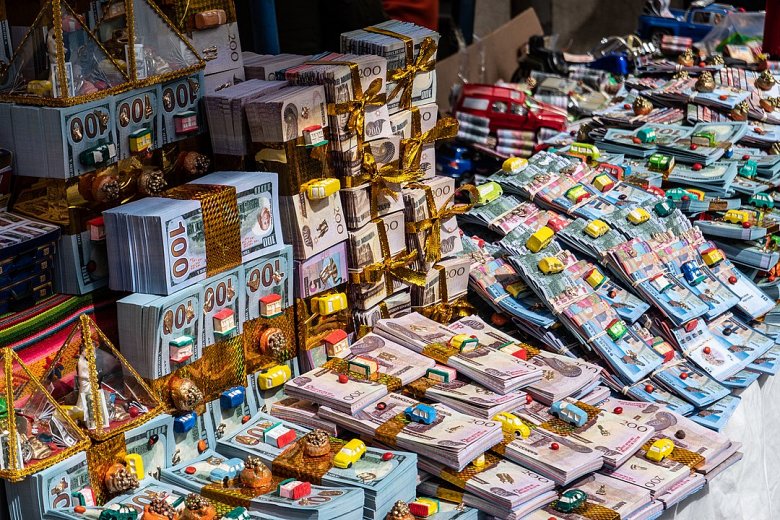
The calendar year starts with a very interesting festival. Alasitas is an Aymara festival of abundance that lasts no less than 3 weeks. During this time, a huge fair pops up in the city of La Paz where people can buy miniature objects (called ‘conopas‘) of everything that they wish for in the coming year. Street stalls get packed with miniature houses, cars, university diplomas, and even travel visas!
In the Andean tradition, installing a miniature object of the desired goods is like sending out a prayer to Ekeko, the god of abundance and prosperity. As a tourist, it’s a great occasion to witness an indigenous tradition and buy nice, meaningful handicrafts.
| Where: | La Paz |
| When: | January |
Aymara New Year (Año Nuevo Andino Amazónico)
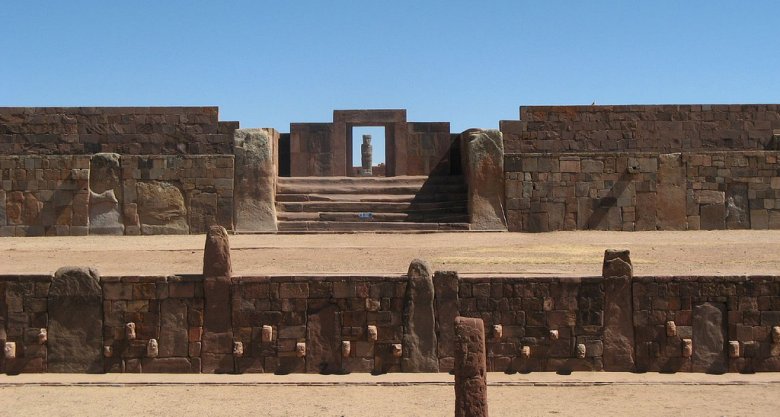
Surprisingly, the Aymara New Year is not celebrated in January but on June 21st at the winter solstice. Also called Willkakuti (“Return of the Sun”), that’s when the high plateaus start to awake and the new agricultural cycle begins.
As opposed to other festivals in this list, the Aymara New Year has a more religious touch to it. In the countryside, you can still witness the sacrifice of baby llamas to Pachamama (Mother Earth) and to Inti (Sun God) during a ceremony at an ‘Inti Punku‘, a sacred place, while waiting for the first rays of the sun with palms facing its ascent.
Although only 25% of the population identifies as Aymara, this celebration is a national holiday since 2005 and a cultural heritage of Bolivia. The epicentre of this celebration is in Tiwanaku, the ancient capital of the Aymara culture; but it’s celebrated in other parts of Bolivia too, such as Potosì, Cochabamba and Santa Cruz.
| Where: | Mainly Tiwanaku, west of La Paz |
| When: | June |
Interested in gods and beliefs? You’ll love our post about the Andean mythology.
Virgin of Copacabana Festival (Fiesta de la Virgen de la Candelaria)

The Virgin of Copacabana is a religious festival at the border between Bolivia and Peru, in the main towns around Lake Titicaca: Copacabana (Bolivia) and Puno (Peru). The Virgin of Candelaria is the patron saint of the two towns.
As for the celebration, there’s a parade in both towns. In Copacabana, the street parade consists of dancing, colourful costumes, music and drinking; while in Puno there’s a procession during which the statue of the Virgin is carried around. Although the Virgin is a Christian character, the celebration is a fascinating mix of Christian and Aymara traditions.
| Where: | Around Lake Titicaca, at Copacabana (Bolivia) and Puno (Peru) |
| When: | February |
Festival of the Virgin of Urkupiña (Fiesta de la Virgen de Urkupiña)

This is yet again a very traditional festival in a small town called Quillacollo, in Cochabamba district. Every year in August, hundreds of visitors come down to town to take part in this idiosyncratic festival celebrating both the Virgin Mary and Pachamama, the mother Earth. This is particularly interesting if you want to witness the peculiar mix of the Catholic and Andean belief systems. Oh, but there’s also music, dancing and colourful costumes of course.
August is traditionally the month dedicated to the Virgin Mary. She’s celebrated in various towns across Bolivia, involving processions, folklore dances and music and (of all things) bull fights.
| Where: | Quillacollo in Cochabamba district |
| When: | August |
Carnival in Oruro
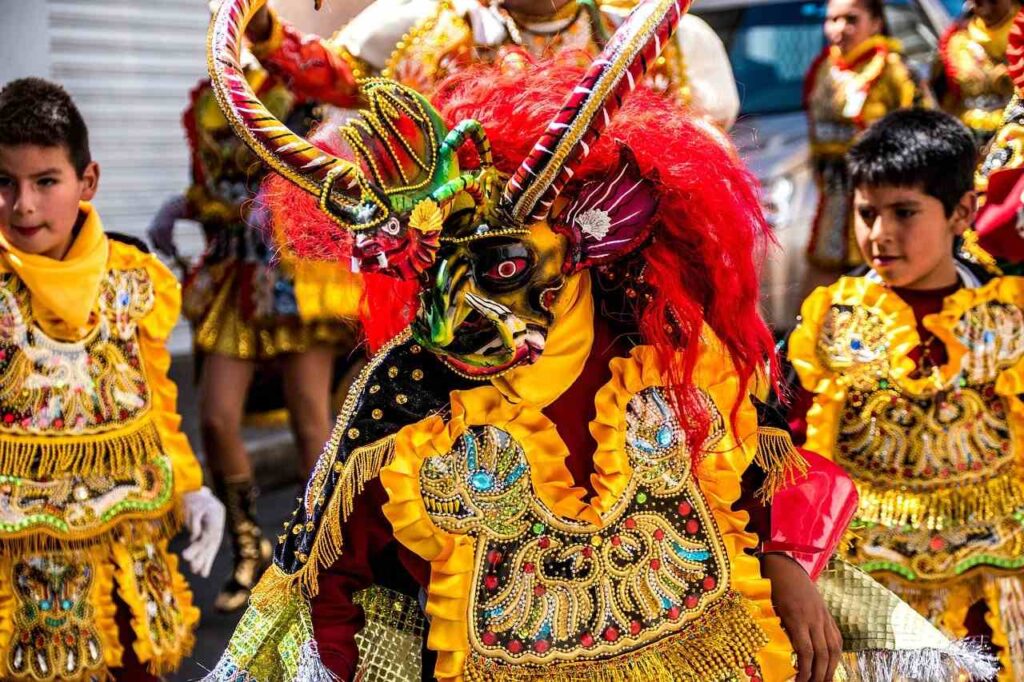
Oruro, halfway between La Paz and Sucre, is considered the folklore capital of the country. It’s definitely the best city to celebrate the carnival in Bolivia. The biggest street parade takes place here with 48 folklore ensembles coming from all over the country. They perform various types of traditional dances in beautiful, colourful costumes.
The Carnival of Oruro is particularly famous for its masks, representing different personas. Each character has its own personality and role within the parade. Artists often spend months crafting the masks and dresses, turning them into real moving artworks.
It’s the biggest event in the country, gathering 400,000 people each year, among which many travellers. Bolivia’s 2nd most important Carnival happens in Santa Cruz.
| Where: | Oruro |
| When: | February |
Not enough of carnivals? Check out how Brazilians do it in Rio and during other Brazilian festivals.
Pukllay (Pujllay de Tarabuco)
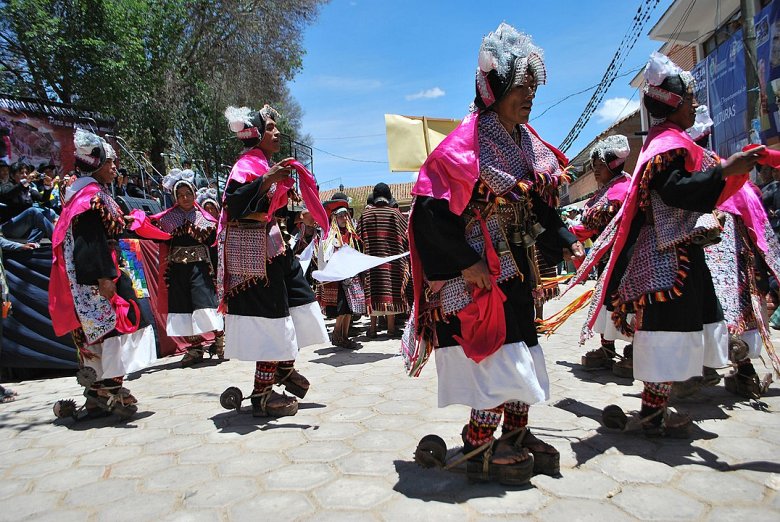
The Pukllay (or Pujllay) in the small town of Tarabuco is an indigenous affair that will catch you off-guard. A traditional celebration of the Yampara people, it commemorates every year their victory over the Spanish colons in 1816. The name comes from a ritual dance that belongs to that very people and is traditionally performed on this occasion.
Like most festivals in Bolivia, it’s loud, colourful and vibrant; but it’s also unique in its shape and rhythms. In fact, it’s an Intangible Cultural Heritage on the UNESCO list since 2011.
| Where: | Tarabuco (Chuquisaca department) |
| When: | 2nd Sunday in March |
Holy Week (Semana Santa)
The Holy Week is celebrated in every country in South America and is as important there as it is in Spain. It’s the week right before Easter Sunday, filled with music, dancing, processions, church services, concerts and food.
The Semana Santa is celebrated throughout Bolivia, even in smaller towns. One of its central places is Copacabana, on the shore of the Titicaca Lake, an important place for the Catholic religion in Bolivia.
During the procession, a statue of Jesus is carried throughout the city, followed by the celebrating crowd. It’s a good opportunity to visit old churches, which often prepare a special program for this occasion: baroque music, special service, festive decoration.
Foodie travellers can also try some special Semana Santa food prepared traditionally and without meat.
| Where: | Throughout the country |
| When: | March or April |
Festival of Our Lord of the Great Power (Nuestro Señor del Gran Poder)

Although it’s Jesus we’re celebrating here under the name Gran Poder, this Bolivian festival is not your typical (and let’s say it: rather gloomy) Christian festival. Actually, it’s there again a mix of Catholic and Aymara traditions. There’s a lot of alcohol, colourful dancing and street party involved.
This festival is celebrated in La Paz and each district has its own folkloric traditions and rituals, showing an impressive diversity. According to some calculations, about 3000 dancers take part in this festival. When attending, make sure you throw the first sip of your drink to the ground, as an offering to the Pachamama for good luck. Yes, the Pachamama lies also under the asphalt.
| Where: | La Paz |
| When: | May or June, depending on the year |
Festival of San Pedro (La Fiesta de San Pedro)
The San Pedro festival takes place at the most important indigenous area of the country, Lake Titicaca. It is home to many Quechua legends and is situated at the border between Bolivia and Peru. During the festival, there are parades and dances which depict historical or everyday events of the people. There are also water sports competitions taking place on the lake, and dancing.
This festival attracts many tourists due to its unique location and folkloric importance.
| Where: | Titicaca Lake |
| When: | June |
Festival of San Juan (Fiesta de San Juan)
San Juan is another religious festival, celebrating this time San Juan Bautista. But this time, it also coincides with the winter solstice and the start of the harvest in Bolivia. Just like many Bolivian festivals, this one is also filled with a lot of alcohol, and is well-known for the traditional big bonfire and fire-walking shows.
In fact, there are many beliefs around the fire, the coal and the ashes. For example, one can read the future in the ashes of the San Juan bonfire; and who walks on the hot coals at midnight won’t burn their feet. (Green Mochila is not responsible for any injury if you decide to experiment.) Nowadays, in big cities, bonfires are mostly replaced with barbecues.
| Where: | Throughout the country |
| When: | June 23rd |
San Andres Festival (Wayllunk’as de San Andrés)
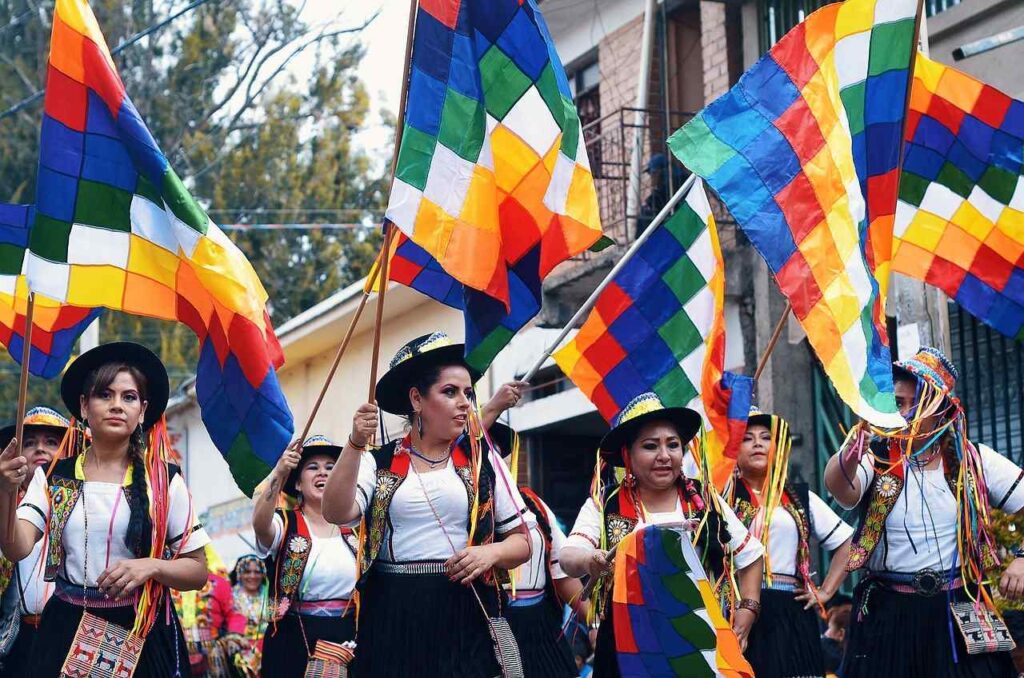
Yet another parade/dancing/music festival, this time in Cochabamba, where San Andres and the Andean religion are both celebrated at the same time. This one-day festival serves as a blessing for the fertility of the land, which still gives livelihood to many Bolivians. This is one of the most traditional festivals where you can least expect to meet tourists.
| Where: | La Taquiña region, Cochabamba |
| When: | November 30th |
Another great harvest festival takes place in Mendoza, Argentina. Check out the most awesome Argentinian festivals!
University Festival (Entrada Universitaria)
Not many countries can boast that their university festival made it to the top events, can they? Students of Bolivia celebrate in July their admission to the university with traditional dances. There’s a street parade (“entrada“) in La Paz with music and incredible costumes; but also small groups of students dancing together throughout many other towns.
The biggest event is in La Paz, related to the Universidad Mayor de San Andrés (UMSA) which is the biggest university in Bolivia. But most other cities (such as the famous student town, Sucre) also join in. Since the goal is to keep alive traditions, the University festival is a good showcase of Bolivian dances and music.
Anthony certainly had fun at this great festival when he visited Bolivia for the first time, while he was on a scholarship in Argentina. (would be good to add a piiic to this festival.. will look)
| Where: | Most cities |
| When: | Last Saturday in July |
Visit Bolivia and attend the best Bolivian festivals!
Bolivia is one of the most interesting countries for cultural travellers. Tourism is relatively underdeveloped compared to other South American countries. Since a big part of its population is indigenous, this implies a pretty interesting cultural experience for any visitor. Check out our backpacking guide to Bolivia and plan your trip with our preferred Bolivian itinerary, designed for cultural travellers for a 2 or 3-week trip.
For more Bolivian celebrations and festivals, check out this great festival calendar.
★
Are you planning a trip to Bolivia? Which of these festivals will be on your list?
Tell us in the comments section below!
Like it? Pin it!




